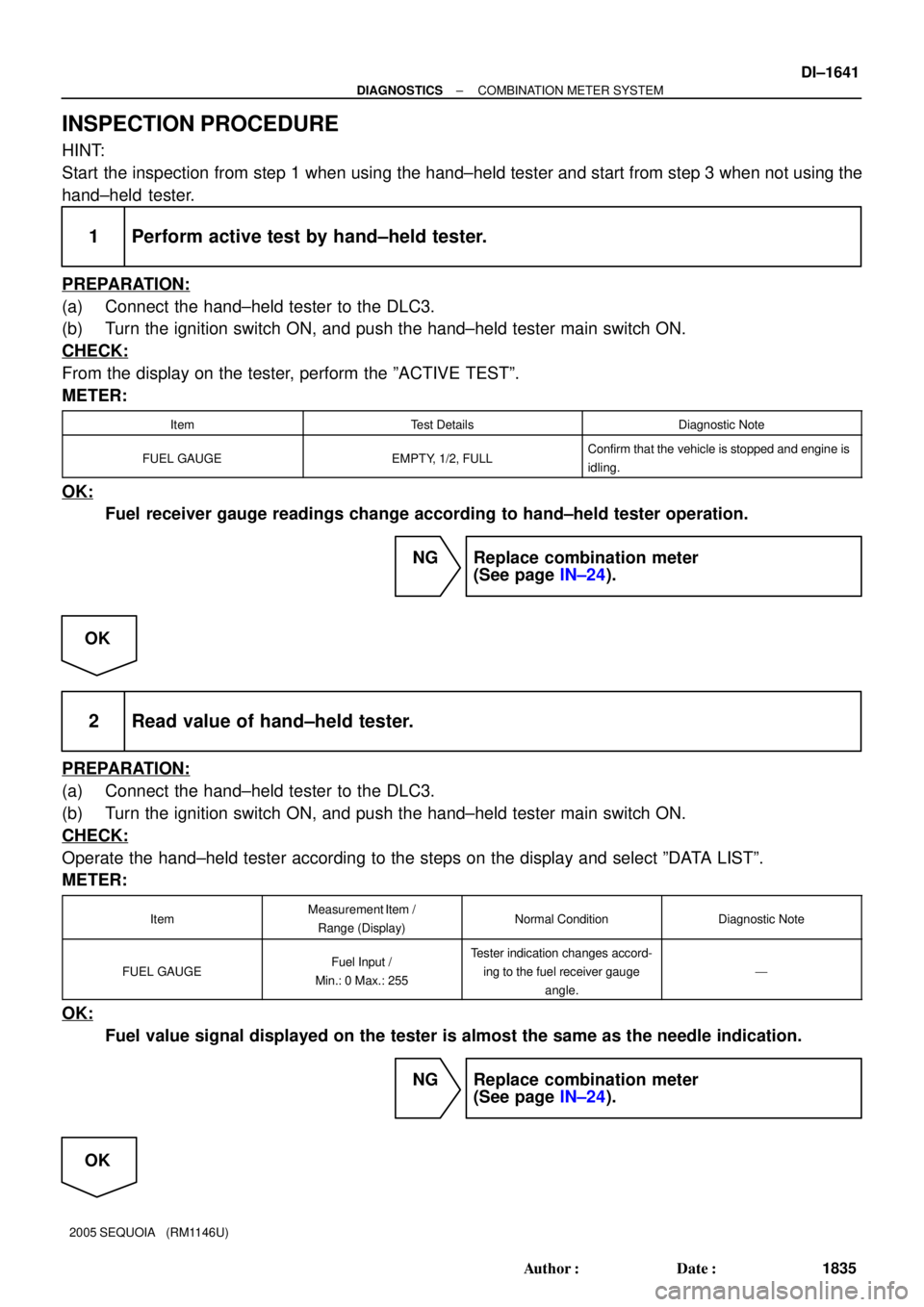Page 1828 of 4323

DID8X±01
DI±1626
± DIAGNOSTICSCOMBINATION METER SYSTEM
1820 Author�: Date�:
2005 SEQUOIA (RM1146U)
DATA LIST / ACTIVE TEST
DATA LIST
According to the DATA LIST displayed by the hand±held tester, you can read the values of the switches,
sensors, actuators and so on without part removal. Reading the DATA LIST as the first step of troubleshoot-
ing is one method to shorten labor time.
(a) Warm up the engine.
(b) Turn the ignition switch off.
(c) Connect the hand±held tester to the DLC3.
(d) Turn the ignition switch to the ON position.
(e) Operate the hand±held tester according to the steps on the display and select ºDATA LISTº.
METER:
ItemMeasurement Item /
Range (Display)Normal ConditionDiagnostic Note
SPEED METER
Vehicle Speed Meter /
Min.: 0 km/h (0 mph)
Max.: 255 km/h (158 mph)Almost the same as actual vehicle
speed (When driving)
TACHO METEREngine RPM /
Min.: 0 rpm Max.: 12,750 rpmAlmost the same as actual engine
speed (When engine is running)
FUEL GAUGEFuel Input /
Min.: 0 Max.: 255Tester indication changes accord-
ing to the fuel receiver gauge
angle.
LIGHT RHEOSTATLight Control Rheostat /
Min.: 0 Max.: 255Light control rheostat switch is
Dark (0) " Bright (255)
OIL GAUGEOil Gauge /
Min.: 0 Max.: 255Tester indication changes accord-
ing to the oil pressure receiver
gauge angle.
ODO/TRIP SWODO / TRIP
ODO/TRIP switch / ON/OFFON: Switch is pushed
OFF: Switch is released
Page 1829 of 4323

± DIAGNOSTICSCOMBINATION METER SYSTEM
DI±1627
1821 Author�: Date�:
2005 SEQUOIA (RM1146U)
ACTIVE TEST
Performing the ACTIVE TEST using the hand±held tester allows the meters, indicators and so on to operate
without part removal. Performing the ACTIVE TEST as the first step of troubleshooting is one way to shorten
labor time.
It is possible to display the DATA LIST on the hand±held tester during the ACTIVE TEST.
(a) Connect the hand±held tester to the DLC3.
(b) Turn the ignition switch to the ON position.
(c) From the display on the tester, perform the ºACTIVE TESTº.
METER:
ItemTest DetailsDiagnostic Note
SPEED METER
Operate speedometer: 0 / 40 (24) / 80 (48) / 120
(72) / 160 (96) /
200 (120) km/h (mph)The needle position should be within the accept-
able tolerance
TACHOMETER
Operate tachometer:
0 rpm / 1,000 rpm / 2,000 rpm / 3,000 rpm /
4,000 rpm / 5,000 rpm / 6,000 rpm / 7,000 rpmConfirm that the vehicle is stopped and engine is
idling.
FUEL GAUGEOperate fuel gauge: EMPTY, 1/2, FULLConfirm that the vehicle is stopped and engine is
idling.
COOLANT TEMPOperate engine coolant temperature receiver
gauge: HIGH / NORMAL / LOW (OFF)Confirm that the vehicle is stopped and engine is
idling.
D BELT REMINDOperate driver's seat belt warning light:
OFF / ONConfirm that the vehicle is stopped and engine is
idling.
OPEN DOOR WARNOperate open door warning light:
OFF / ONConfirm that the vehicle is stopped and engine is
idling.
LOW FUEL WARNOperate fuel level warning light:
OFF / ONConfirm that the vehicle is stopped and engine is
idling.
TAILLIGHT INDICOperate taillight indicator light:
OFF / ONConfirm that the vehicle is stopped and engine is
idling.
HEADLIGHT INDICOperate Hi±beam indicator light:
OFF / ONConfirm that the vehicle is stopped and engine is
idling.
SRS WARNOperate SRS warning light:
OFF / ONConfirm that the vehicle is stopped and engine is
idling.
ODO/TRIP DISPOperate ODO/TRIP display: OFF / ONConfirm that the vehicle is stopped and engine is
idling.
KEY REMND BUZZROperate key reminder buzzer: OFF / ONConfirm that the vehicle is stopped and engine is
idling.
SEAT BELT BUZZROperate driver's seat belt warning buzzer:
OFF / ONConfirm that the vehicle is stopped and engine is
idling.
MAINT REQDOperate oil maintenance indicator light:
OFF / ONConfirm that the vehicle is stopped and engine is
idling.
VOLT METEROperate volt meter: 9 V / 12 V / 15 V / 18VConfirm that the vehicle is stopped and engine is
idling.
OIL PRESS METEROperate oil pressure meter: HIGH, 3/4, 1/2, 1/4,
LOW (OFF)Confirm that the vehicle is stopped and engine is
idling.
Page 1842 of 4323
I28560
F19
Fuel SenderCombination Meter
C6 C5
12 26
11
C6 BB1
J8
J/C
IEJ49 J48
BB1
1F 1D96
BR W±B Y±B Y±B Y±BVV V
1 4
2 3AG J/C
A G
AJ49 J48 DI±1640
± DIAGNOSTICSCOMBINATION METER SYSTEM
1834 Author�: Date�:
2005 SEQUOIA (RM1146U)
Malfunction in fuel receiver gauge
CIRCUIT DESCRIPTION
The fuel sender has a variable resistance mechanism. The resistance decreases when the fuel amount in-
creases, and the resistance increases when the fuel amount decreases.
The fuel receiver gauge changes based on the resistance of the fuel sender.
WIRING DIAGRAM
DID91±01
Page 1843 of 4323

± DIAGNOSTICSCOMBINATION METER SYSTEM
DI±1641
1835 Author�: Date�:
2005 SEQUOIA (RM1146U)
INSPECTION PROCEDURE
HINT:
Start the inspection from step 1 when using the hand±held tester and start from step 3 when not using the
hand±held tester.
1 Perform active test by hand±held tester.
PREPARATION:
(a) Connect the hand±held tester to the DLC3.
(b) Turn the ignition switch ON, and push the hand±held tester main switch ON.
CHECK:
From the display on the tester, perform the ºACTIVE TESTº.
METER:
ItemTest DetailsDiagnostic Note
FUEL GAUGEEMPTY, 1/2, FULLConfirm that the vehicle is stopped and engine is
idling.
OK:
Fuel receiver gauge readings change according to hand±held tester operation.
NG Replace combination meter
(See page IN±24).
OK
2 Read value of hand±held tester.
PREPARATION:
(a) Connect the hand±held tester to the DLC3.
(b) Turn the ignition switch ON, and push the hand±held tester main switch ON.
CHECK:
Operate the hand±held tester according to the steps on the display and select ºDATA LISTº.
METER:
ItemMeasurement Item /
Range (Display)Normal ConditionDiagnostic Note
FUEL GAUGEFuel Input /
Min.: 0 Max.: 255Tester indication changes accord-
ing to the fuel receiver gauge
angle.
OK:
Fuel value signal displayed on the tester is almost the same as the needle indication.
NG Replace combination meter
(See page IN±24).
OK
Page 1844 of 4323
I28574
F
Float
E
321
DI±1642
± DIAGNOSTICSCOMBINATION METER SYSTEM
1836 Author�: Date�:
2005 SEQUOIA (RM1146U)
3 Inspect fuel receiver gauge.
PREPARATION:
Remove the fuel sender gauge assy.
CHECK:
(a) Measure the resistance between terminals 2 and 3 of the
connector according to the value(s) in the table below.
OK:
Float levelSpecified condition
F3 to 5 W
E107.5 to 112.5 W
NG Replace fuel sender gauge.
OK
Page 1845 of 4323
I28569C5±26
Combination Meter:
I28570C6±12
Combination Meter:
C6±11
I28575
Fuel Sender Gauge
Connector Front View:
F19
± DIAGNOSTICSCOMBINATION METER SYSTEM
DI±1643
1837 Author�: Date�:
2005 SEQUOIA (RM1146U)
4 Check harness and connector (Fuel sender gauge ± combination meter).
PREPARATION:
Disconnect the combination meter connector.
CHECK:
Measure the resistance according to the value(s) in the table
below.
OK:
Tester connectionConditionSpecified condition
C5±26 ± F19±2AlwaysBelow 1 W
C6±11 ± F19±3AlwaysBelow 1 W
C6±12 ± Body groundAlwaysBelow 1 W
C5±26 ± Body groundAlways10 kW or higher
C6±11 ± Body groundAlways10 kW or higher
NG Repair or replace harness or connector.
OK
Replace combination meter
(See page IN±35).
Page 2168 of 4323

DI±1966
± DIAGNOSTICSAUDIO SYSTEM
2160 Author�: Date�:
2005 SEQUOIA (RM1146U)
5. Identify the condition in which the noise occurs, and check the noise filter on the related part.
Condition in which noise occursNoise Source
Depressing the acceleration pedal increases the noise, and stopping the
engine stops the noise immediately.Generator
Noise occurs during A/C or the heater operation.Blower motor
Rapid acceleration while driving on an unpaved road or after the ignition
switch is turned on makes noise.Fuel pump
Pressing and then releasing the horn switch, and keeping pressing the horn
switch makes unusual noise.Horn
Quiet noise is heard while the engine is running, but stops with the engine.Ignition
Noise occurs synchronously with the turn signal flash.Flasher
Noise occurs during window washer operation.Washer
Noise occurs while the engine is running, and it continues even after the en-
gine stops.Engine coolant temperature sensor
Noise occurs during wiper operation.Wiper
Noise occurs when the brake pedal is depressed.Stop light switch
Others.Static electricity stored on the vehicle
Reference:
�Make sure first that there is no noise from outside. Failing to do so makes the noise source detec-
tion difficult and leads to misdiagnosis.
�The noise should be removed in descending order of loudness.
�Tuning the radio so that no station is received wakes the noise more noticeable, making the rec-
ognition of the phenomenon easier.
Page 2229 of 4323

± DIAGNOSTICSAUDIO SYSTEM
DI±2027
2221 Author�: Date�:
2005 SEQUOIA (RM1146U)
Noise occurs
INSPECTION PROCEDURE
1 Check of speaker installation.
CHECK:
Check if each speaker is securely installed.
OK:
Each speaker is securely installed.
HINT:
The radio is equipped with a noise prevention system that blocks excessively loud noise. If such noise oc-
curs, check the all wiring is proper and that the antenna installation part ground and noise±prevention equip-
ment are installed.
Condition in which noise occursNoise type
Noise increases when the accelerator pedal is depressed, but stops when
the engine is stopped.Generator noise
Noise occurs during A/C or the heater operation.Blower motor noise
Noise occurs when the vehicle accelerates rapidly on an unpaved road or
after the ignition switch is turned on.Fuel pump noise
Noise occurs when the horn switch is pressed and released or when pressed
and held.Horn noise
Quiet noise occurs while the engine is running, but stops when the engine is
stopped.Ignition noise
Noise occurs synchronously with the blink of the turn signal.Flasher noise
Noise occurs during window washer operation.Washer noise
Noise occurs while the engine is running, and it continues even after the en-
gine is stopped.Water temperature sensor noise
Noise occurs during wiper operation.Wiper noise
Noise occurs when the brake pedal is depressed.Stop light switch noise
Others.Static electricity stored on the vehicle
HINT:
�Identify the condition under which the noise occurs, and check the noise filter on the related part.
�First ensure that the noise is not coming from the outside. Failure to do so makes noise source detec-
tion difficult and may lead to a misdiagnosis.
�Noise should be removed in descending order of loudness.
NG Install it properly.
OK
Identification of noise source (See page DI±1964).
DIDA3±01